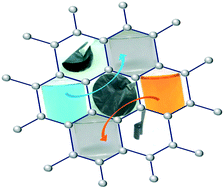Surface-tailored graphene oxide paper: an efficient filter for dye pollutants†
Abstract
The potential application of graphene as a filter paper for selectively removing cationic and anionic dyes from aqueous solutions is demonstrated herein. A surface-tailored graphene paper was fabricated by the vacuum filtration technique on a microporous substrate to remove two different classes of dyes. A negatively charged graphene paper was fabricated from graphene oxide (GO) solution, and a positively charged graphene paper was fabricated from polyallylamine-functionalized GO solution. The solutions of methylene blue (MB) and methyl orange (MO) were filtered through the negatively charged graphene paper (GO−) and positively charged graphene paper (GO+). The stacking structure of the GO− and GO+ paper successfully removed the MB and MO mixtures from the solution. The GO− and GO+ paper demonstrated a high retention rate of 99.8% for MB dye and 99.5% for MO dye. The pore size of the paper was found to be less than 7 nm, providing more insights into the rejection mechanism. The rejection mechanism involves the adsorption and electrostatic interaction (i.e., cationic–anionic interaction) between the dye and graphene sheets, which result in the fast and efficient removal of the dye. The GO paper displayed adsorption capacities as high as 311 and 340 mg g−1 for MB and MO dyes, respectively. The results indicate that the surface-tailored graphene paper is a great alternative for the next generation cost-effective filters in practical water purification applications.

- This article is part of the themed collection: Environmental Science: Water Research & Technology Cover Art


 Please wait while we load your content...
Please wait while we load your content...